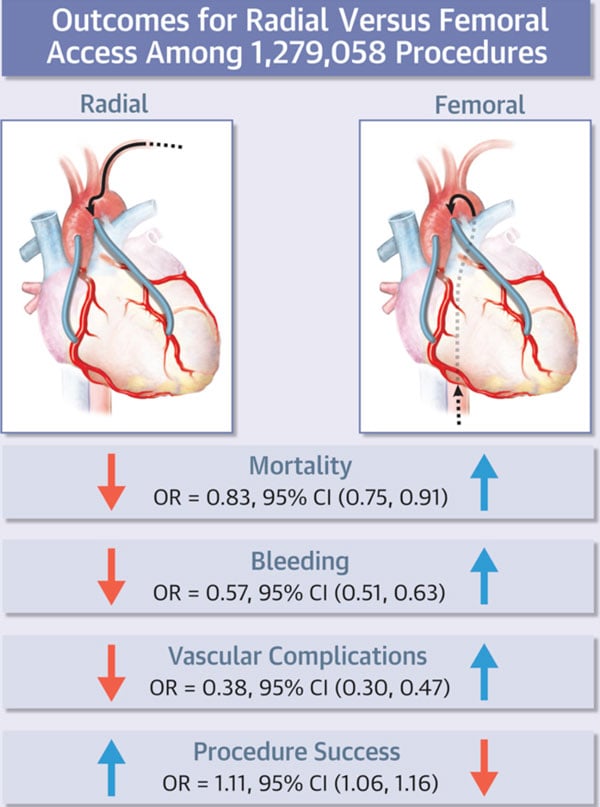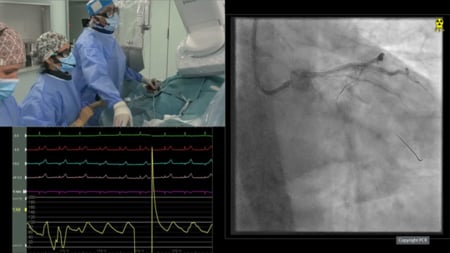07 Apr 2021
Characteristics and outcomes of patients with history of CABG undergoing cardiac catheterization via the radial versus femoral approach
Selected in JACC: Cardiovascular Interventions by S. Brugaletta
The aims of this study were to examine clinical and procedural outcomes in post-CABG patients who underwent diagnostic catheterization and/or PCI via the radial or femoral approach.
References
Authors
David A. Manly, Wassef Karrowni, Jennifer A. Rymer, Lisa A. Kaltenbach, Rajesh V. Swaminathan, John C. Messenger, J. Dawn Abbott, Arnold Seto, Carmelo Panetta, Emmanouil Brilakis, Ilias Nikolakopoulos, Ian C. Gilchrist, Prashant Kaul, Habib Dakik, and Sunil V. Rao
Reference
10.1016/j.jcin.2021.01.053
Published
March 2021
Link
Read the abstractReviewer
Latest contributions
Optical coherence tomography- vs angiography-guided coronary stent implantation in calcified lesions: the ILUMIEN IV trial Percutaneous coronary treatment with Bioadaptor implant vs drug-eluting stent : 2-year outcomes from BIOADAPTOR RCT Coronary revascularisation deferral based on quantitative flow ratio or fractional flow reserve: a post-hoc analysis of the FAVOR III Europe trialMy Comment
Why this study? – the rationale/objective
There are limited data comparing outcomes of patients with prior CABG undergoing transradial or transfemoral diagnostic catheterization and/or PCI.
The aims of this study were to examine clinical and procedural outcomes in post-CABG patients who underwent diagnostic catheterization and/or PCI via the radial or femoral approach.
How was it executed? – the methodology
Using the National Cardiovascular Data Registry CathPCI Registry, all diagnostic catheterizations and PCIs performed in patients with prior CABG from July 1, 2009 to March 31, 2018 (n = 1,279,058 patients, 1,173 sites) were evaluated.
Temporal trends in transradial access were examined, and mortality, bleeding, vascular complications, and procedural metrics were compared between transradial and transfemoral access.
What is the main result?
The rate of transradial access increased from 1.4 % to 18.7 % over the study period.
Transradial access was associated with decreased mortality (adjusted odds ratio [OR]: 0.83 ; 95 % confidence interval [CI]: 0.75 to 0.91), decreased bleeding (OR: 0.57 ; 95 % CI: 0.51 to 0.63), decreased vascular complications (OR: 0.38 ; 95 % CI: 0.30 to 0.47), increased PCI procedural success (OR: 1.11 ; 95 % CI: 1.06 to 1.16; p < 0.0001), and significantly decreased contrast volume across all procedure types.
Transradial access was associated with shorter fluoroscopy time for PCI-only procedures but longer fluoroscopy time for diagnostic procedures plus ad hoc PCI and diagnostic procedures only.
Operators with a higher rate of transradial access in non-CABG patients were more likely to perform transradial access in patients with prior CABG.

Source: JACC: Cardiovascular Interventions
Critical reading and the relevance for clinical practice:
It is well known that radial access is more comfortable for the patient and it is also associated with reduced bleeding rate and mortality, especially in ACS patients.
This present study analyzes a very common situation in our daily life, which is the catheterization of CABG patients. In these patients, considering the presence of left internal mammary artery, left radial access is usually performed, but there are no data comparing such access vs. femoral approach.
Over a period of 9 years, an increase of transradial access is seen, together with a decreased mortality, bleeding, vascular complications as compared to femoral access. It is surprising to see in 2018 less than 18.7 % of radial procedure in these patients and reasons for this are not well explained.
Of note also the fact that an increase in PCI procedural success is seen with radial vs. femoral access: this may be explained by learning curve, not only in making this access, but also in making PCI over the 9 years of the study, as those operators with higher rate of radial access are likely those with more experience as compared to operators who use femoral access.





1 comment
It is hard to understand so low frequency in the use of the radial approach in patients after CABG- In our practice the left radial approach is the default approach in this type of patients reserving the femoral approach just in patients with RIMA in situ or with left radial graft. More than the previously commented advantages we found and easier cannulation of the LIMA trough this approach. Recently we added the use of the left distal radial approach that convert the procedure in a more comfortable one for the operator providing also preservation of the proximal left radial access site